The best NFT marketplaces are OpenSea, Rarible, Crypto.com, Mintable, Nifty Gateway, Binance NFT, SuperRare, Axie Marketplace, Foundation, Solanart, and NBA Top Shot. These platforms provide users with a convenient way to buy, sell, and trade non-fungible tokens (NFTs).
It can be challenging to decide the best NFT platforms from over 80 available marketplaces, so we’ve reviewed various NFT sites and compared them based on their supported NFT categories, fees, security, usability & customizable features, and pros and cons.
In addition to the in-depth review, this article covers the 11 best NFT marketplaces to buy and sell NFTs, what an NFT marketplace is, and a step-by-step guide on how to buy NFTs on the top NFT marketplaces. But before we proceed, here’s a detailed comparison of the top 11 marketplaces on our list.
| NFT Marketplace | Transaction Fees | Royalties | Supported NFT Categories |
| OpenSea | 2.5% | 10% | Gaming, art, domains, photography, etc. |
| Rarible | 2.5% | 50% | Gaming items, art, music, and collectibles. |
| Crypto.com | 5% | 10% | Art, gaming, music, sports, and cross-chain NFTs. |
| Mintable | 2.5 – 10% | Customizable | Virtual real estate, collectibles, arts, and music. |
| Nifty Gateway | Varies | 5% + $0.30 | Music, art, and branded drops. |
| Binance NFT | 1% | 1-10% | Art, sports, gaming, and collectibles. |
| SuperRare | 3% | 10% | Videos, 3D images, art, etc. |
| Axie Marketplace | 4.25% (sellers) | 1% (when buyer uses a creator’s code during purchase). | Gaming (dedicated video game, Axie Infinity) |
| Foundation | 5% | 10% | Art |
| Solanart | 3% | Customizable | Digital art and PFP projects. |
| NBA Top Shot | 5% | 5% | Sports |
1. OpenSea
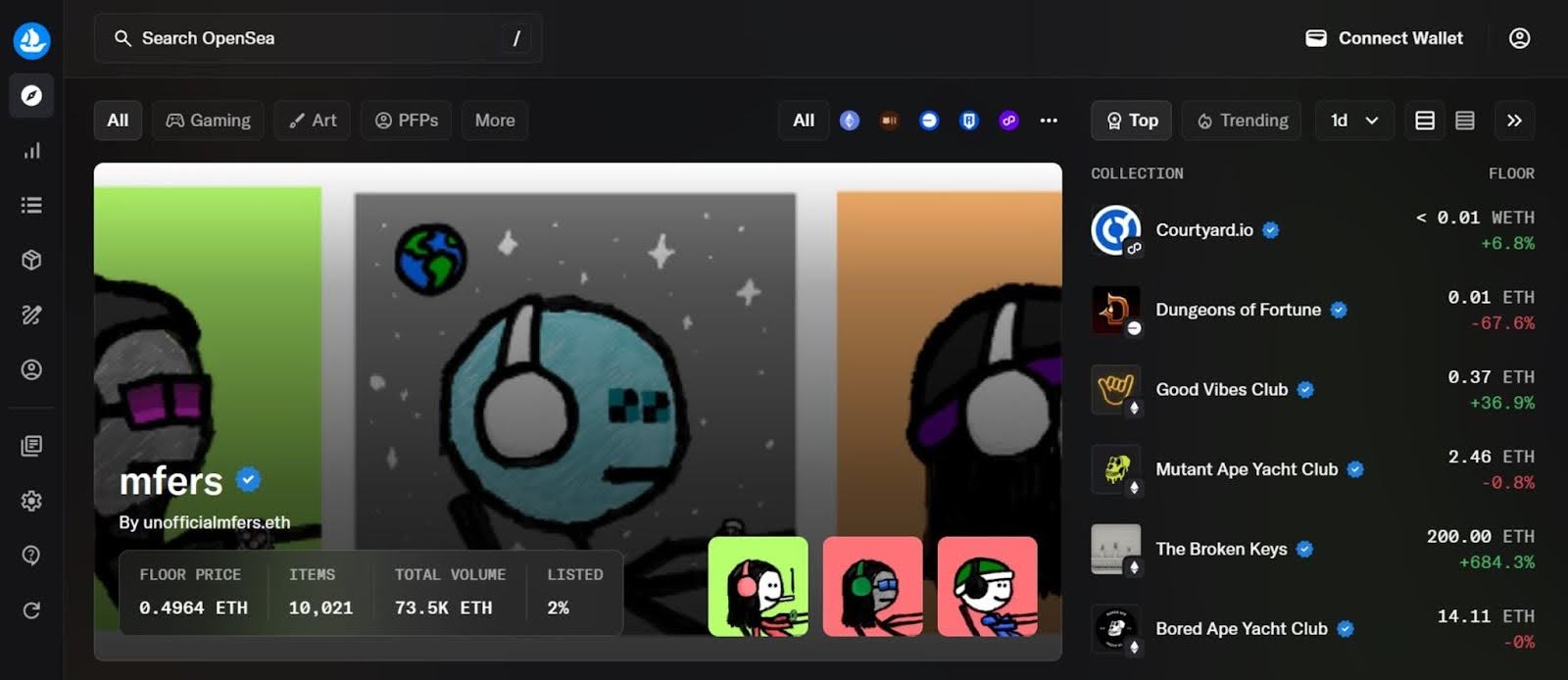
OpenSea is the world’s first and largest marketplace for buying, selling, and trading digital products, including NFTs and crypto collectibles. It was launched in 2017 and supports lots of popular NFTs, including photography, music, virtual worlds, trading cards, memberships, and art.
Pros and Cons of OpenSea
The pros of OpenSea are listed below;
- Easy to navigate, making it suitable for beginners.
- High liquidity, making it potentially easy for buyers to sell NFTs.
- Most extensive collection of NFTs (700+ NFT projects).
The cons of OpenSea are listed below;
- Limited Customer Service.
- Overcrowded marketplace.
- High gas fees.
Number of supported NFTs
OpenSea supports 80+ million NFTs across multiple blockchains.
2. Rarible

Rarible is an open-source marketplace for the minting, buying, and selling of non-fungible token collectibles. It was launched in 2020 as a non-custodial NFT marketplace where creators and buyers can keep full control over their tokens and crypto collectibles.
Pros and Cons of Rarible
The pros of Rarible are listed below;
- Lazy minting feature (creating NFTs without paying gas fees upfront)
- $RARI native governance token
- Up to 50% Royalties for digital artists/creators
The cons of Rarible are listed below;
- Only supports Ethereum-based NFTs.
- Initial connection, listing, and other fees apply.
Number of supported NFTs
Rarible supports over 400,000 NFTs.
3. Crypto.com
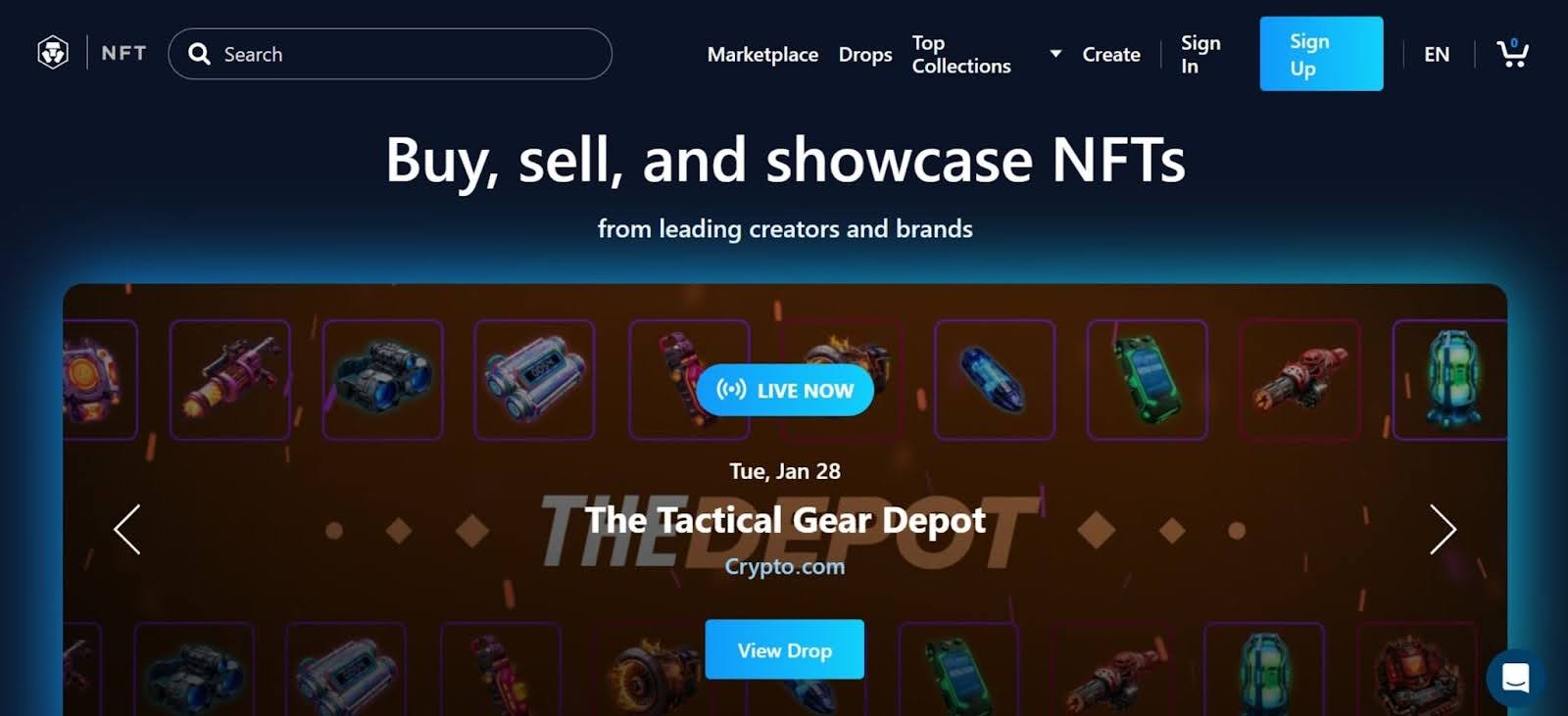
Crypto.com is a cryptocurrency exchange that offers a marketplace for smooth NFT trading due to its interoperability with the Ethereum network and Cosmos. Unlike most NFT marketplaces, which require users to transfer crypto from external wallets, Crypto.com supports multiple cryptocurrencies, making it more convenient for buyers.
Pros and Cons of Crypto.com
The pros of Crypto.com are listed below;
- No gas fees when buying NFTs with the Crypto.com Wallet.
- Minting is free except for a $3 submission fee and a 72-hour review.
- Rarity rankings and customizable price alerts.
The cons of Crypto.com are listed below;
- Customer support is slow and sometimes unsatisfactory.
- Minting takes at least 72 hours.
Number of supported NFTs
Crypto.com supports about 28 safelisted Cronos collections, 22 safelisted Polygon NFT collections, and 57 safelisted ETH collections.
Start trading on Crypto.com and get up to 6,000 USDT in welcome bonuses.
4. Mintable
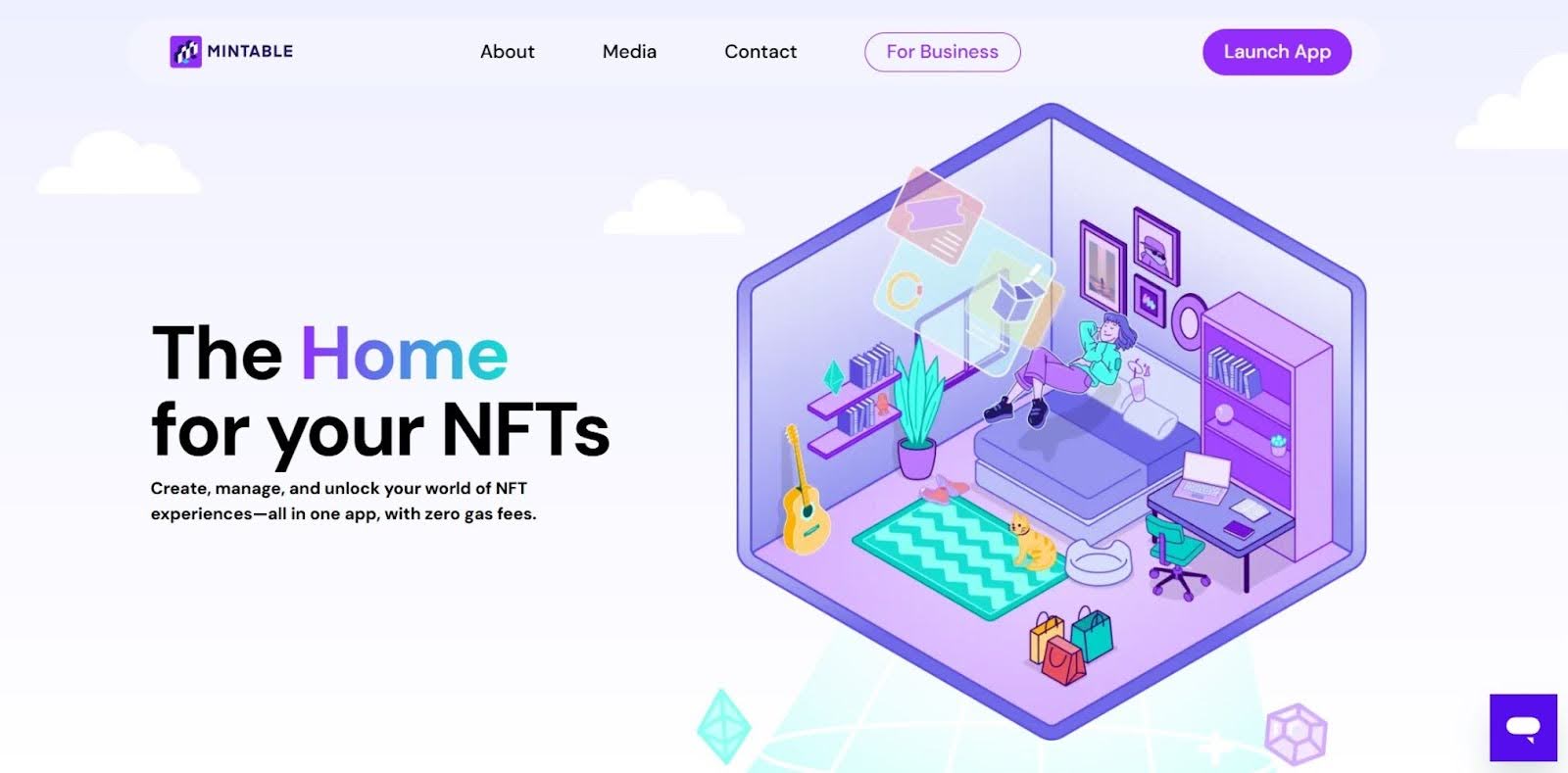
Mintable is an Ethereum-based NFT marketplace founded in 2018. The platform supports various NFT categories, making it one of the most accessible marketplaces for digital artists, musicians, and content creators. Additionally, Mintable allows for gasless minting, which allows users to create NFTs without paying gas fees upfront.
Pros and Cons of Mintable
The pros of Mintable are listed below;
- Gasless NFT minting
- Customizable royalties for artists to earn commissions on secondary sales.
- Integration with Immutable X
The cons of Mintable are listed below;
- Buyers pay Ethereum gas fees during purchase.
- High transaction fees (between 2.5% and 10%).
Number of supported NFTs
Mintable supports thousands of NFTs across various categories, including digital art, membership, access passes, music, videos, collectibles, and domain names.
5. Nifty Gateway

Nifty Gateway is a curated NFT marketplace focused on digital art and collectibles, allowing users to buy, sell, and store NFTs (called “Nifties”) on the Ethereum blockchain. The platform offers exclusive drops from top artists and brands.
Pros and Cons of Nifty Gateway
The pros of Nifty Gateway are listed below;
- No gas fees for minting or listing NFTs.
- Curated, high-quality NFT drops from renowned artists.
- Flexible royalty system for artists.
The cons of Nifty Gateway are listed below;
- Discontinued cross-listing with OpenSea.
- Complex fee structure.
Number of supported NFTs
Nifty Gateway supports 30,000+ entertainment-based NFTs
6. Binance NFT

Binance NFT is a marketplace launched by Binance in 2021 for buying, selling, minting, and trading NFTs (non-fungible tokens). The platform integrates with Binance accounts and supports NFTs across Binance Smart Chain (BSC) and Ethereum.
Pros and Cons of Binance NFT
The pros of Binance NFT are listed below;
- Low transaction fees (1% platform fee on sales).
- Unique features like NFT loans using NFTs as collateral.
- High security and liquidity.
The cons of Binance NFT are listed below;
- Not available to users in the United States.
- Low royalties for creators.
Number of supported NFTs
Binance NFT supports a wide variety of NFTs across categories like premium art, sports, entertainment, gaming, collectibles, esports, and charity-related NFTs.
Open a new account on Binance today and get a discount on trading fees and up to 5,000 USDT in sign-up bonuses.
7. SuperRare
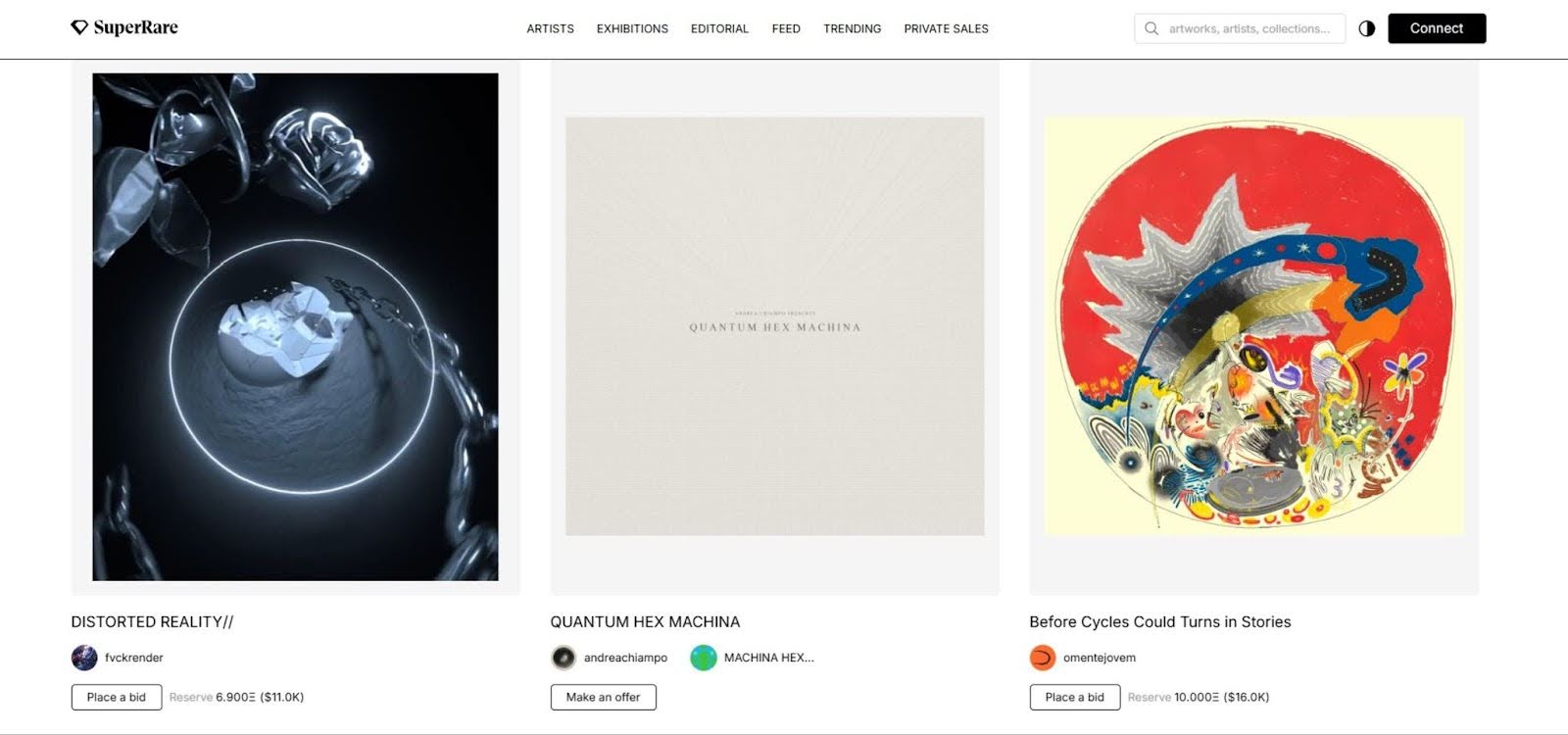
SuperRare is a curated, P2P NFT marketplace that allows artists to mint, showcase, and sell unique ERC-721 NFTs. The platform is known for its strict artist selection process (about 1% acceptance rate) and community-driven governance via the $RARE token.
Pros and Cons of SuperRare
The pros of SuperRare are listed below;
- Curated, high-quality NFT art collection.
- Artists receive 10% royalties on all secondary sales of their work.
- Community governance through the SuperRare DAO.
The cons of SuperRare are listed below;
- High transaction and gallery fees for artists and buyers.
- Only supports Ethereum (ETH) for payments.
Number of supported NFTs
SuperRare supports 32,000+ art-based NFTs.
8. Axie Marketplace
Axie Marketplace is the platform dedicated to Axie-related NFTs, including Axie Infinity, a digital world or video game filled with cute NFT pets known as Axies. You can buy or train and then pit against the Axies of other players to earn rewards. Additionally, Axie Infinity Tokens are built on Ethereum blockchain, so users can buy or sell them on various NFT marketplaces and crypto exchanges.
Pros and Cons of Axie Marketplace
The pros of Axie Marketplace are;
- Strong community engagement.
- Play-to-earn integration
- No marketplace fees for buyers
- Support other NFTs like land plots and in-game items.
The cons of Axie Marketplace are;
- Players need to purchase at least three Axies to start playing.
- Sellers’ fees are relatively high.
Number of supported NFTs
Axie Marketplace supports about 90,601 unique ERC-721 tokens representing land plots, multiple Axies, and other in-game items.
9. Foundation

Foundation is an art-based NFT marketplace built for art collectors, lovers, and connoisseurs. It was launched in 2021 and has since maintained its invite-only model, limiting who can list and sell digital artworks on the platform. In addition to attracting top artists, this model helps maintain a level of quality missing on larger platforms.
Pros and Cons of Foundation
The pros of Foundation are listed below;
- Exclusive/curated NFT marketplace
- 10% royalties on all secondary sales in perpetuity after their initial sale.
- Less crowded marketplace. Easy for artists to have their work seen.
The cons of Foundation are listed below;
- Only accepts ETH for payments
- Artists pay up to 15% commission fees.
Number of supported NFTs
Foundation supports multiple NFTs from over 400 artists with various artworks in 70+ categories.
10. Solanart

Solanart is a decentralized NFT marketplace built on the Solana blockchain, launched in 2021. The marketplace allows users to mint, buy, sell, and trade Solana-based NFTs for low fees. Solanart also provides tools for managing and tracking NFTs and an editable marketplace, allowing users to customize their experience.
Pros and Cons of Solanart
The pros of Solanart are listed below;
- An automatic royalty system that pays creators a percentage of secondary sales.
- High-speed transactions (processing thousands per second)
- Near-zero transaction fees (usually less than $0.01).
The cons of Solanart are listed below;
- Fewer NFT categories, mainly focused on digital art and PFP projects.
- Lower liquidity compared to well-established Ethereum-based platforms.
Number of supported NFTs
Solanart has processed nearly 700,000 NFT sales and supports a wide range of collections, including popular projects like Degenerate Ape Academy, Aurory, SolPunks, and more.
11. NBA Top Shot Marketplace

NBA Top Shot is a game-based NFT marketplace where basketball fans can buy, sell, and trade NFT video highlights of NBA games featuring famous athletes. The platform, created by the NBA and Dapper Labs, allows users to collect and trade moments, which are packaged video clips of game highlights that are minted in limited runs.
Pros and Cons of NBA Top Shot
The pros of NBA Top Shot are listed below;
- Users can pay with debit/credit cards.
- NBA Top Shot is officially licensed by the NBA.
- The risk of counterfeit collectibles is lower than that of other NFT categories.
The cons of NBA Top Shot are listed below;
- Only caters to NBA fans
- NBA Top Shot is a centralized marketplace
- You cannot trade the NFTS outside of the marketplace
Number of supported NFTs
NBA Top Shot supports about 80,000 NBA collectibles.
What Is an NFT Marketplace?
An NFT marketplace is a digital platform where users can buy, sell, trade, and mint Non-Fungible Tokens (NFTs) and other crypto collectibles. These tokens represent unique digital assets, like art, music, domain names, videos, gaming items, or collectibles, and are traded on a peer-to-peer P2P basis.
Since NFTs represent ownership, they cannot be replicated, but can change ownership when one user buys the token from the creator or current owner of the asset.
There are different types of marketplaces in the NFT space that allow collectors and creators to purchase and sell NFTs and crypto collectibles. Below is a list of some frequently traded NFTs by category.
- General NFT Marketplaces
General marketplaces are online platforms that offer an extensive selection of NFTs, ranging from digital art and entertainment to domain names and virtual real estate. Examples of NFT marketplaces that fall into this category are OpenSea and Rarible.
- Art-based NFT Marketplaces
Art-based NFT marketplaces offer art creators a platform to display their creations while providing unique digital art NFTs to art enthusiasts and collectors. Examples of platforms that offer art-based NFT collections are SuperRare and Foundation.
- Entertainment NFT Marketplaces
As the name implies, these platforms offer music, videos, and entertainment-related NFTs. Users can access exclusive content, including music NFTs and videos from artists and also purchase virtual event tickets. With these NFT marketplaces, artists can take full ownership of their work and earn royalties directly.
- Sports NFT Marketplaces
Sports NFT marketplaces like NBA Top Shot allow sports fans, collectors, athletes, and teams to buy, sell, and trade sports-related NFTs. These NFTs represent virtual or physical items like digital trading cards, iconic game highlights or video clips, virtual memorabilia (jerseys, autographs, trophies), and exclusive virtual tickets.
- Decentralized NFT Marketplaces
Decentralized NFT marketplaces are decentralized or community-governed platforms built on blockchain technology. They cover a range of digital assets and allow users to buy, sell, and trade NFTs directly with each other, without intermediaries. Popular examples of decentralized NFT marketplaces are Rarible, OpenSea, and Mintable.
- Gaming NFT Marketplaces
Gaming marketplaces specialize in NFTs tied to video games, such as in-game items, characters, skins, and virtual land. These platforms let players own, trade, and monetize their digital gaming assets. Popular examples are Axie Marketplace and Decentraland.
In addition to these marketplaces, there are also exclusive or curated NFT marketplaces, which are platforms that focus on high-quality, handpicked digital art and collectibles. These platforms have a high entry barrier, ensuring that only vetted or invited creators can list their work. Popular examples are SuperRare, Nifty Gateway, and Foundation.
What is the Best NFT Marketplace?
The best NFT marketplaces are OpenSea, Rarible, Crypto.com, Mintable, Nifty Gateway, Binance NFT, SuperRare, Axie Marketplace, Foundation, Solanart, and NBA Top Shot. The best NFT marketplace for you will depend on your needs and interests.
For instance, if you prefer a large selection of collectibles, OpenSea and Rarible are great options. For sport and gaming enthusiasts and collectors, NBA Top Shot and Axie Marketplace are ideal. However, if you want a platform that offers a standard NFT market and comprehensive cryptocurrency trading tools, you should opt for Binance NFT or Crypto.com.
Next Read: You can learn more about the Binance platform and features in this Binance review.
How Does an NFT Marketplace Work?
NFT marketplaces provide a platform where creators can list their digital assets, such as art, music, videos, or collectibles. Buyers can browse these listings and either purchase NFTs at a fixed price or bid on them in auctions, depending on the seller’s preferences.
Beyond buying and selling, many marketplaces also support minting, which allows creators to generate new NFTs by uploading digital content and paying a network (or gas) fee if required by the platform.
NFT marketplaces can be centralized or decentralized. Centralized platforms manage custody and act as intermediaries, while decentralized marketplaces operate on-chain, using smart contracts to automate transactions and transfers of ownership without a middleman.
In either case, when a user buys or sells an NFT, the marketplace executes the transaction and transfers ownership securely on the blockchain.
Most NFT marketplaces require you to connect an external crypto wallet to purchase NFTs. If you are using a platform that requires this process, you can choose a compatible wallet from our comprehensive list of the best crypto wallets.
Once you have an account on a crypto wallet, fund it with the required cryptocurrency (e.g, ETH or SOL) and connect to the NFT market to start buying. Fortunately, if you prefer transacting with fiat currencies, you can opt for marketplaces that support traditional payment methods like debit or credit cards.
How to Choose the Best NFT Platforms?
To choose the best NFT trading platforms, consider factors like NFT category, fees, security, usability & and customizable features.
- NFT Category
There are different types of NFT marketplaces, with some specializing in digital sports, while others lean into artworks, curated NFTs, music, gaming, or utility tokens. Knowing the category a platform falls into will help you decide if it aligns with your needs. For instance, art collectors should choose platforms that support NFT art and not sports collectibles.
- Fees
All marketplaces charge fees for listing, buying, or withdrawing, and these fees differ, depending on the platform and the supported blockchains. So, before buying, selling, or minting NFTs on any marketplace, compare transaction fees, commission rates, creators’ royalties, and any additional charges.
- Security
Ensure the platform has strong security measures to protect you against hacking and fraud. The best NFT marketplaces have robust security, such as two-factor authentication and encryption. Also, check to see if they would be able to compensate users for any losses.
- Usability and Customizable Features
A good NFT marketplace should be easy to use and have straightforward processes for creating, minting, buying, and selling NFTs. This is especially important for users who are new to NFT trading. In addition to usability, check if the marketplace offers customizable NFTs, fees, auctions, fractional ownership, and other advanced platform features.
Where is the Best Place to Buy and Sell NFTs?
The best place to buy and sell NFTs is OpenSea, especially for general digital asset collectors. The platform offers digital artworks, music, domain names, and other NFT categories, catering to users of all levels. In addition to its selection of 700+ NFT projects, it supports multiple blockchain networks, has a low entry barrier, and charges low fees (2.5%).
What is the Best NFT Platform for Beginners?
The best NFT platforms for beginners are Rarible, OpenSea, and Binance NFT. Rarible lets anyone create, buy, and sell NFTs without prior approval or upfront costs, making it ideal for beginners.
On the other hand, OpenSea is another option for beginners since it is the largest and one of the longest-standing NFT marketplaces. It is also ideal because it provides gas-free options for minting.
However, if you are looking for platforms with even lower fees, Binance NFT is an excellent option. It offers low fees, high liquidity, and an easy onboarding process, making it a good choice for beginners and those already using Binance for crypto trading.
How to Buy NFTs on Top NFT Marketplaces?
To buy NFTs on top marketplaces, you need to open an account in a crypto wallet, fund your account, and then transfer crypto to the NFT marketplace. Once you’ve made the transfer, you can browse listings and purchase NFTs. Here is a step-by-step guide you can follow.
Set Up a Cryptocurrency Wallet
Step 1: Download a Crypto Wallet
Find out and download the wallet that your NFT marketplace supports; popular options are Metamask and Coinbase Wallet. Once you’ve installed the browser extension (we’re using Metamask Chrome), you will arrive at the first selection screen.
Step 2: Set up Your Account
If this is your first time setting up a wallet, click “Create a Wallet”. If you have an existing software wallet (Trust Wallet, Rainbow Wallet, etc) and want to move over to MetaMask, select “Import wallet”.
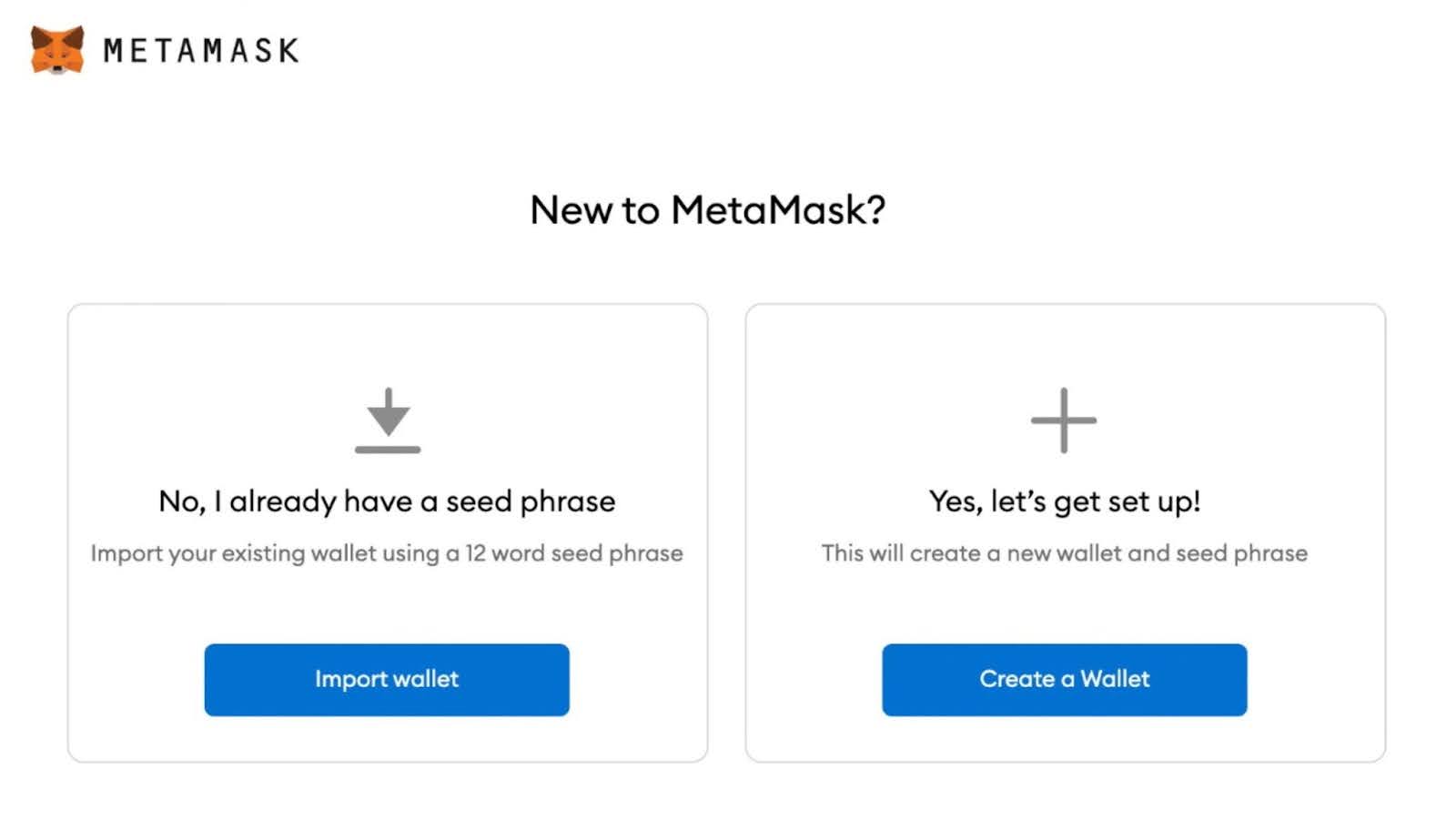
Step 3: Create a Password
Create a secure password that you will use to sign in to your Metamask account. Next, you will receive a 12-word phrase and will be asked to confirm this phrase by entering it back into the app. Store this safely, as losing it means losing access to your crypto assets.
Step 4: Transfer Cryptocurrency to Your Wallet
Metamask uses Ethereum (ETH) as its primary currency. To buy, click the “Buy/Sell” to buy from third-party payment platforms or click “Deposit” to transfer from another digital wallet and select “Ethereum”. Copy your wallet address and transfer ETH to it. Once your ETH is transferred, it will appear in your wallet within minutes.
Buying NFTs on Top Marketplaces (e.g, Using OpenSea)
Step 1: Log in to OpenSea and Connect Your Wallet: Visit the OpenSea website and click “Login” at the top right corner of the homepage. Connect your digital wallet by clicking the wallet icon in the top right corner.
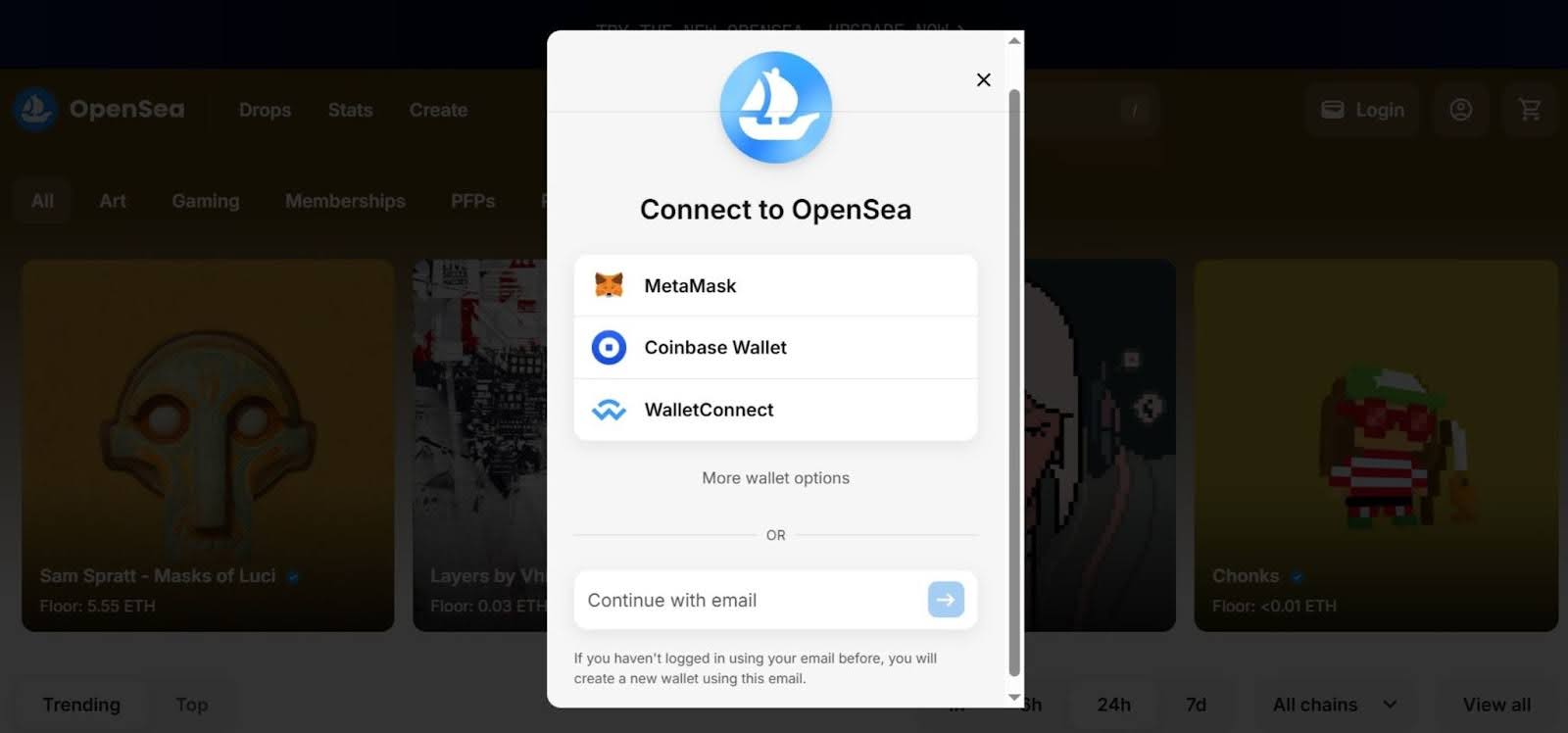
Step 2: Browse the Marketplace: Search for NFTs using filters for categories, price ranges, or specific collections. When you find an NFT you want to purchase, click on it to view details.
Step 3: Buy NFT: For fixed-price listings, click “Buy Now” and confirm the transaction in your wallet. For auctions, place a bid and wait until the live auction ends. Approve the transaction in your wallet interface and pay the gas fees.
Once the transaction is complete, the NFT will appear in your wallet and your OpenSea profile.
Which Platform is the Biggest NFT Marketplace?
The biggest NFT marketplace is OpenSea. It is the first and largest NFT market, supporting a wide variety of digital assets including art, music, domain names, trading cards, and virtual worlds across multiple blockchains.
The post Best NFT Marketplaces: Top 11 Platforms to Buy and Sell NFTs in 2025 appeared first on CryptoNinjas.


